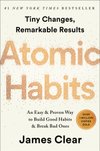
Saved by Dean Millson
Atomic Habits

Saved by Dean Millson
If you can’t find a game where the odds are stacked in your favor, create one. Scott Adams, the cartoonist behind Dilbert, says, “Everyone has at least a few areas in which they could be in the top 25% with some effort.20 In my case, I can draw better than most people, but I’m hardly an artist. And I’m not any funnier than the average standup
... See moreIf you look at the most habit-forming products, you’ll notice that one of the things these goods and services do best is remove little bits of friction from your life. Meal delivery services reduce the friction of shopping for groceries. Dating apps reduce the friction of making social introductions. Ride-sharing services reduce the friction of
... See moreLook around. Society is filled with highly engineered versions of reality that are more attractive than the world our ancestors evolved in. Stores feature mannequins with exaggerated hips and breasts to sell clothes. Social media delivers more “likes” and praise in a few minutes than we could ever get in the office or at home. Online porn splices
... See moreOther processed foods enhance dynamic contrast, which refers to items with a combination of sensations, like crunchy and creamy. Imagine the gooeyness of melted cheese on top of a crispy pizza crust, or the crunch of an Oreo cookie combined with its smooth center. With natural, unprocessed foods, you tend to experience the same sensations over and
... See moreInstead of summoning a new dose of willpower whenever you want to do the right thing, your energy would be better spent optimizing your environment. This is the secret to self-control. Make the cues of your good habits obvious and the cues of your bad habits invisible.
Environment is the invisible hand that shapes human behavior. Despite our unique personalities, certain behaviors tend to arise again and again under certain environmental conditions. In church, people tend to talk in whispers. On a dark street, people act wary and guarded.
This is one of the most surprising insights about our habits: you don’t need to be aware of the cue for a habit to begin. You can notice an opportunity and take action without dedicating conscious attention to it. This is what makes habits useful.
It’s also what makes them dangerous. As habits form, your actions come under the direction of your
Finally, the response delivers a reward. Rewards are the end goal of every habit. The cue is about noticing the reward. The craving is about wanting the reward. The response is about obtaining the reward. We chase rewards because they serve two purposes: (1) they satisfy us and (2) they teach us.